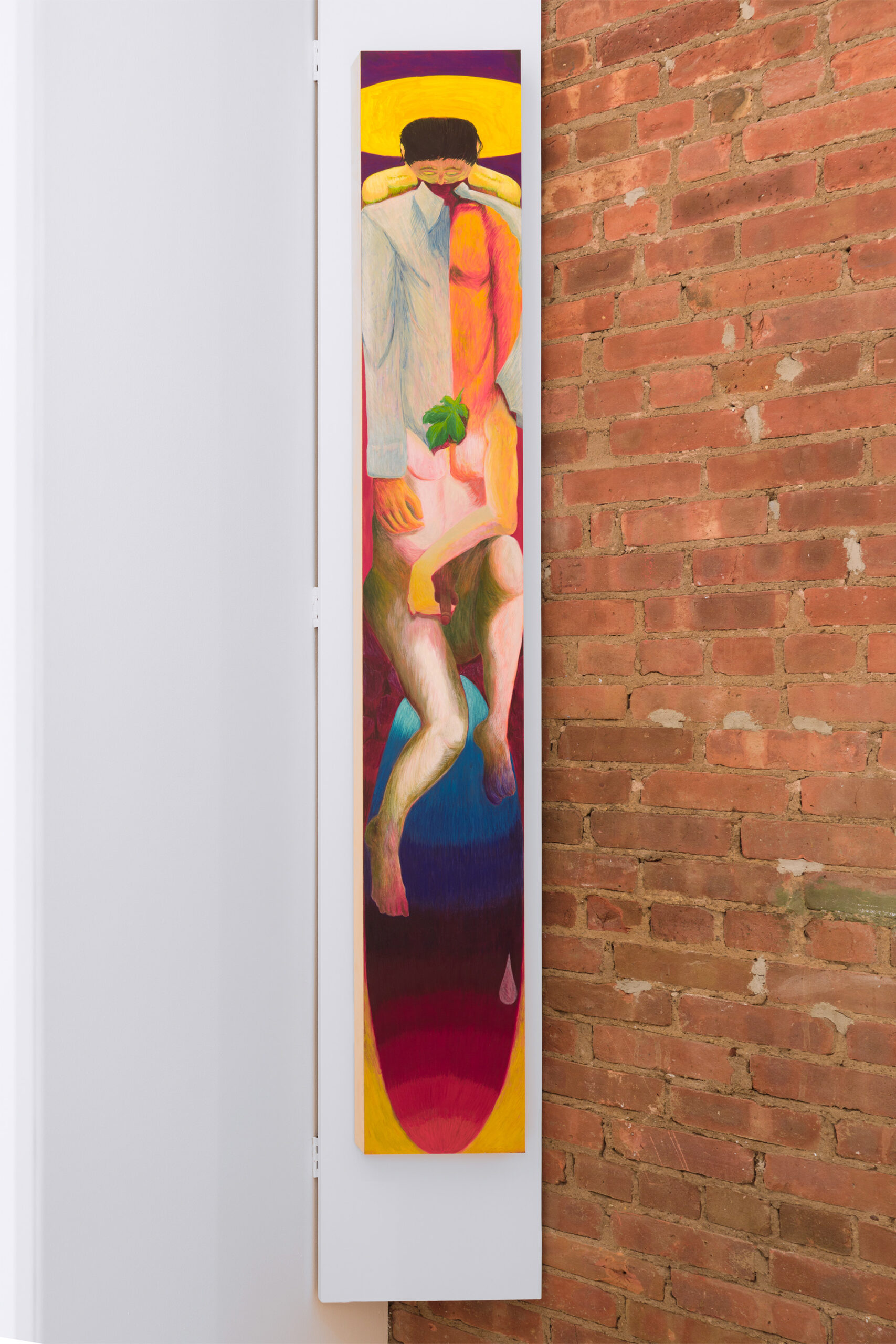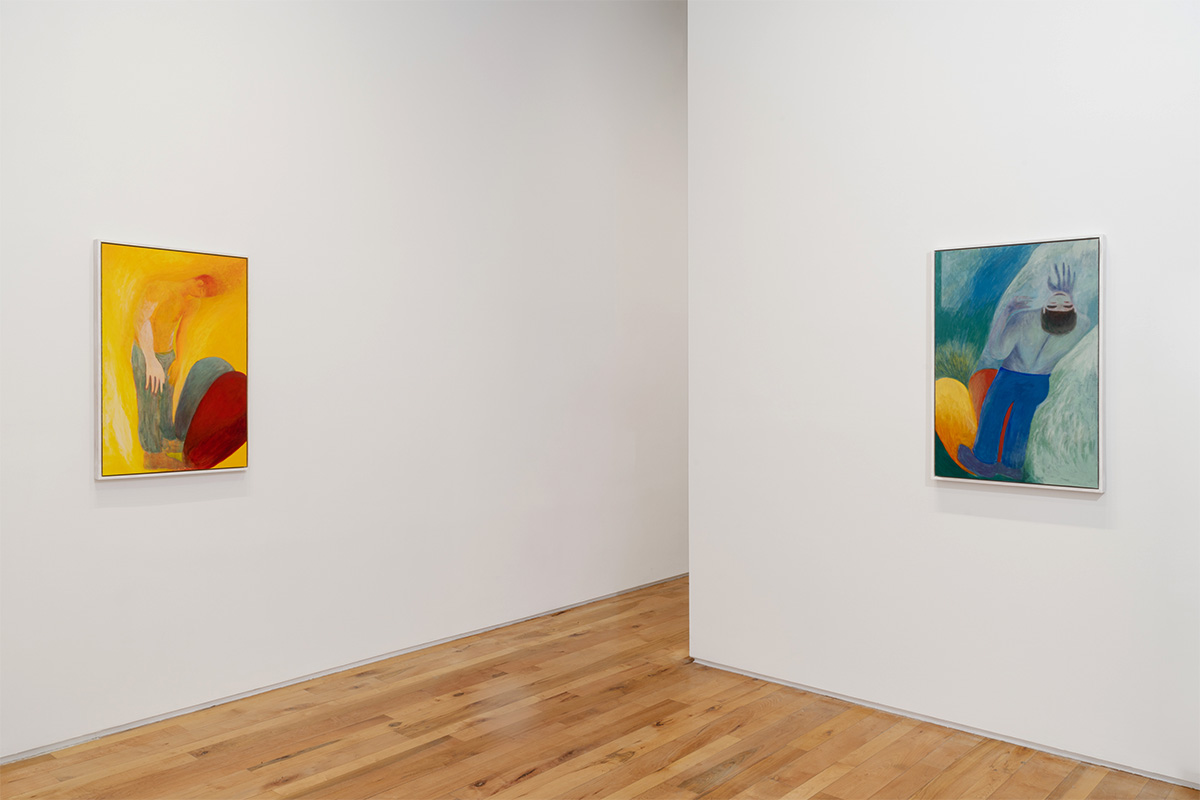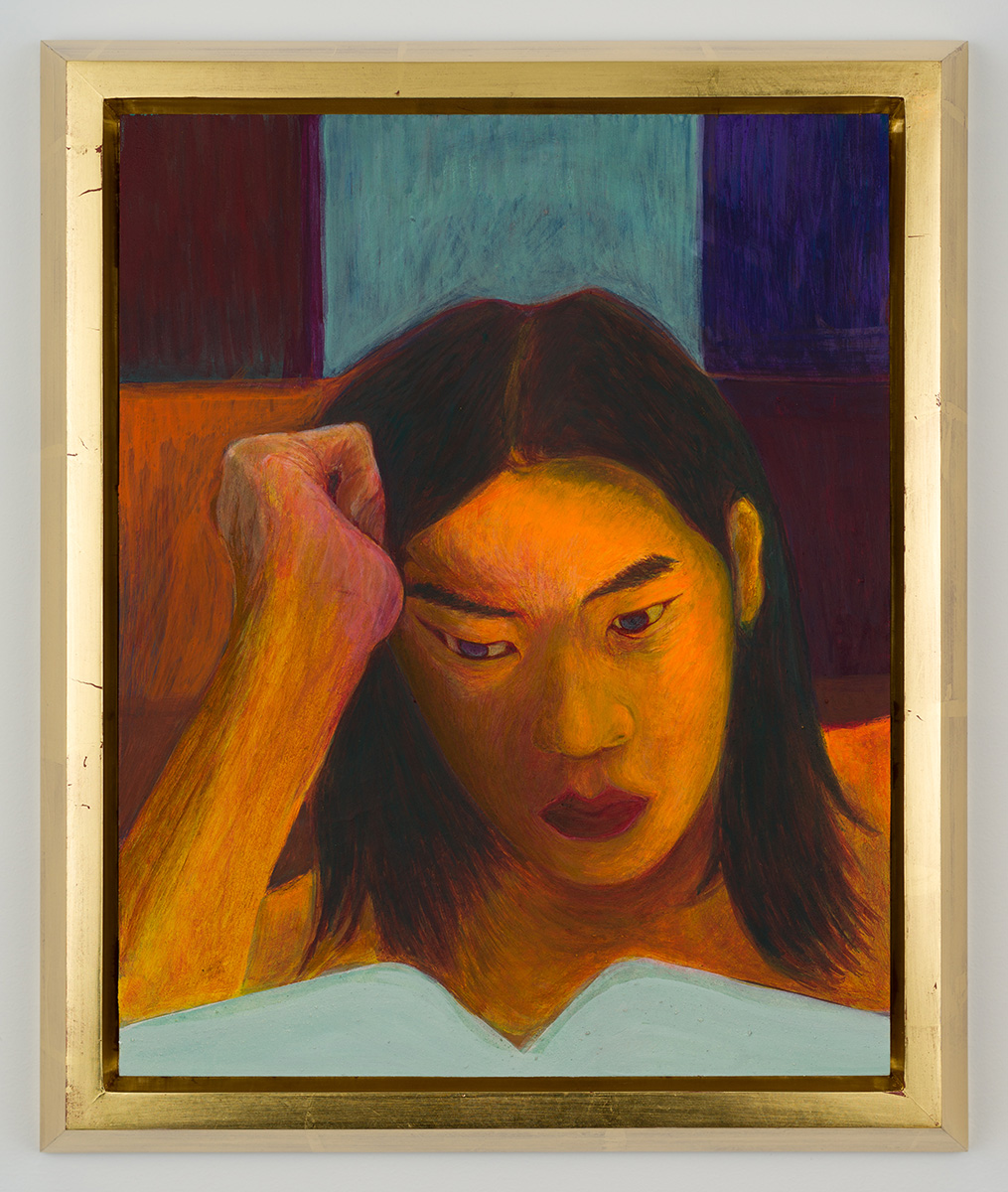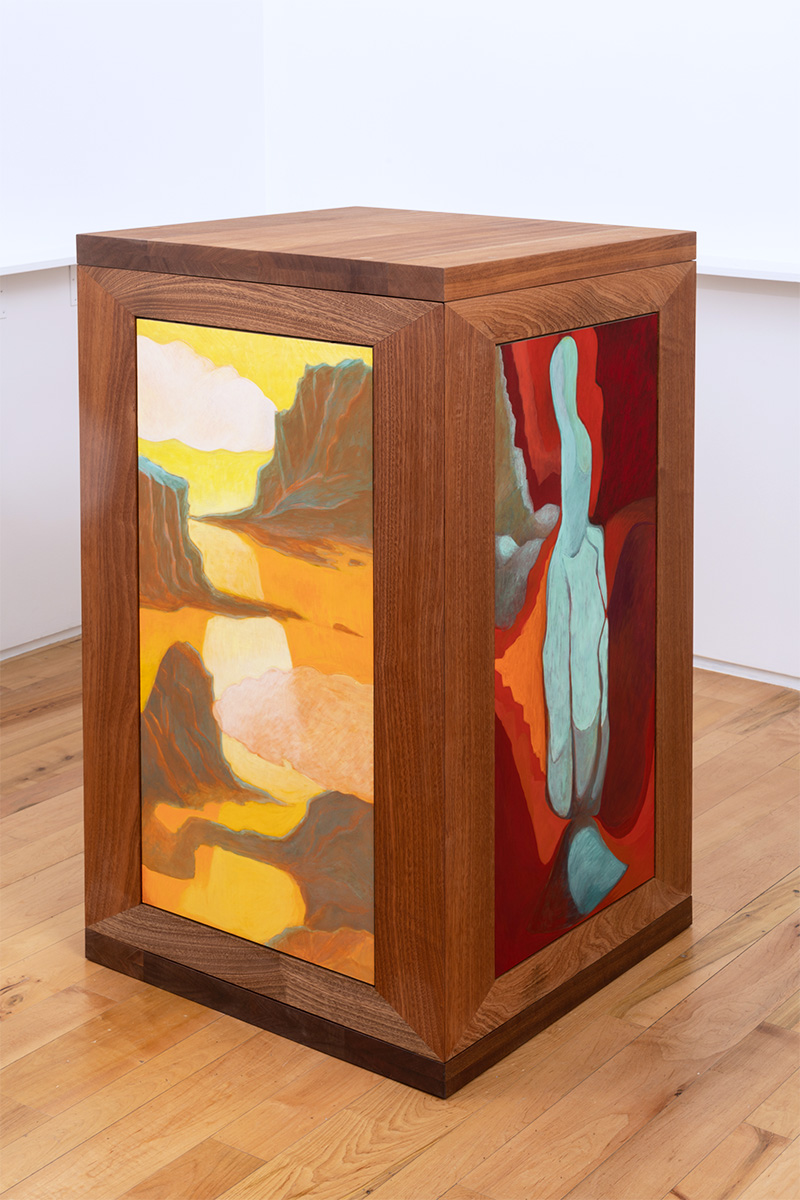Damien H. Ding Explores the Mechanisms of Desire in Private Paintings at Denny Gallery
By Maria Owen
March 9, 2023
 Installation view of Damien H. Ding, “Hero’s Journey,” 2022-23, egg tempera on panel and mahogany construct, Box: 45 3/4 x 28 x 28 inches, Five panels: 42 x 146 inches; courtesy of the artist and Denny Gallery.
Installation view of Damien H. Ding, “Hero’s Journey,” 2022-23, egg tempera on panel and mahogany construct, Box: 45 3/4 x 28 x 28 inches, Five panels: 42 x 146 inches; courtesy of the artist and Denny Gallery.
On February 17, at around 6:58 PM, a crowd of people gathered inside Denny Gallery on Lispenard Street in New York, packed together in a fashion reminiscent of morning rush hour on the L train. From over the heads of eager attendees, one could see the artist begin the deconstruction of a large painted box in the corner of the room. With great care, the artwork was divided panel by panel and placed along the wall, forming an altar of five vibrant scenes. As the fifth and final painting was set in place, the audience—their curiosity satiated—cheered.
That artist, Damien H. Ding, is concerned with a liminal state of desire, seeking to capture, convey, and evoke it through composition, macro and micro-level narratives, and beguiling designs. The show “Private Paintings,” on view through March 25, is brimming with figures in a state of change, sharing in conceptual subtleties and marked by colors that swallow the viewer whole. These works are immediate—precious, yet mysterious. They demand time but reward generously with thoughtful forms and luxurious color. Ding, whose work has long employed hidden elements and historic footnotes, spoke to Whitewall about the beauty of seeking, the erasure of self, and the traces of past states left behind.
WHITEWALL: At your opening the other night, you waited until halfway through to deconstruct A Hero’s Journey so that it could be viewed as a whole. What was your intention there?
DAMIEN H. DING: Well, I’m a little antagonistic. The point was to make the viewer wait. There’s such a flood of images today that we take them for granted. There’s pressure on artists to be constantly making things and sharing them. I’m not interested in that. I don’t need people to see my work; I want them to want to see it. That’s why I build in these mechanisms of desire. I’m inviting people to engage a little more.
 Installation view of Damien H. Ding, “My painting,” 2021, egg tempera on panel, 72 x 10 inches; courtesy of the artist and Denny Gallery.
Installation view of Damien H. Ding, “My painting,” 2021, egg tempera on panel, 72 x 10 inches; courtesy of the artist and Denny Gallery.
WW: My painting is a bit like that as well––it’s installed in a private cove of the gallery, a little out of the way.
DHD: As painters, we put ourselves in this situation where we are so self-important, but simultaneously we’re known for being insecure. I wanted to build a figure that embodies this introverted yet egoistic figure. My painting is hidden away so that you have to spend time, be patient, discover it slowly. It doesn’t convey everything at once. A big part of my work is this idea of shyness, and building a feeling of anticipation. Paintings can be shy, they don’t necessarily want to reveal everything at once.
WW: Let’s go back to A Hero’s Journey. It’s the first piece you see. There’s a narrative, but it’s almost cyclical.
DHD: When I first conceptualized that piece, there was a very concrete story to it. As the work developed, it became more ambiguous––not cyclical, but abstracted. I tend to build in more ambiguities as I sketch things out. Even the title, Hero’s Journey, points to a familiar narrative, but the painted scenes confound that specificity.
I was thinking about this archetype of the hero as we generally understand it, a protagonist in pursuit of fame, fortune, love, etcetera. The images begin more abstractly and lead into descriptive narratives: figures in landscapes, paths, and a bicycle. In the middle panel (or the internal one, if the piece is closed), there’s an amalgamation of these elements—the ambiguity of the outer scenes and descriptiveness of the inner ones. Here, at the end of the journey, in the attainment of his ineffable prize, there’s an erasure of the individual. He’s effaced by color and abstraction.
 Installation view of Damien H. Ding, “Becoming – Yellow” and “Becoming – Blue” in “Damien H. Ding: Private Paintings”; courtesy of the artist and Denny Gallery.
Installation view of Damien H. Ding, “Becoming – Yellow” and “Becoming – Blue” in “Damien H. Ding: Private Paintings”; courtesy of the artist and Denny Gallery.
WW: And these two narratives––Hero’s Journey and My painting––lead towards the same apex. There’s a tangible story and then something metaphysical. This sense of before and after, form and shadow, shows up in the Becoming series, too.
DHD: The shadows are that which lingers. The Becoming series is about transformation. But in this process, something stays behind. The attitudes of the figures towards the shadows in the Becoming paintings are very different, and indicate where in the process each figure is––one is forlorn, one ambivalent, one fleeing in contempt. There is something else hidden there, too, but I’ll keep it a secret.
WW: Also hidden are a few clues pointing to your background in art history––how does that experience inform your visual and conceptual language?
DHD: There are some clear references––for example, I paint in tempera. It’s a loaded medium, referential of religious iconography, medieval painting, illuminated manuscripts. I’m working with panels arranged in an ark and then a screen, like a religious iconostasis. I also think about the painting in the contemporary context, and how it is often over-simplified to be this struggle between figuration and abstraction. I think about these things, but when I paint, all I think about is how to make a good painting: composition, texture, color, line, edges, shape. I consider the history, but ultimately I’m making the work in a very present state.
In a linear reading of art history, Modernism attempted to essentialize what painting should be. In that process, we gained certain things, but lost much as well. To compare two artists who dealt deeply with conflict and war, Goya created such hauntingly deep, potent works, whereas Picasso’s Guernica, supposedly considered a Modernist masterpiece for its emotional depth, never did it for me. I find the work almost too intellectualized.
In pursuing our desires, in painting, in anything, when you gain something, you lose something. When you attain or transcend, you also efface. I’m interested in the desire to elevate oneself, but what we risk leaving behind in pursuit of that desire is what really gets me.
 Damien H. Ding, “Self portrait with color-field background,” 2022, Egg tempera on panel, Artwork: 10 x 8 inches, Framed: 12 x 10 x 1 1/2 inches; courtesy of the artist and Denny Gallery.
Damien H. Ding, “Self portrait with color-field background,” 2022, Egg tempera on panel, Artwork: 10 x 8 inches, Framed: 12 x 10 x 1 1/2 inches; courtesy of the artist and Denny Gallery.
WW: Is this experience of gain and loss echoed in your self-portrait as well?
DHD: In certain ways. The meaning is really in the title: Self portrait with color-field background. Color-field is a reference to Postwar abstraction and my working so directly with pigments.
The idea that there is this contemporary colorfulness that dominates Western painting—especially American painting—has become so common that it’s almost become a point of insecurity. Yet, I know that I love color; and it has power over me. One of my favorite experiences viewing art was with Barnett Newman’s Onement I. I remember that red just overwhelming me and thinking: that works.
 Damien H. Ding, “Blue and white 青白,” 2022, oil on linen, 80 x 54 inches; courtesy of the artist and Denny Gallery.
Damien H. Ding, “Blue and white 青白,” 2022, oil on linen, 80 x 54 inches; courtesy of the artist and Denny Gallery.
WW: The largest panel in the exhibition is titled Blue and white 青白, another art historical reference. How does this fit into your larger exploration of transformation and desire?
DHD: In the same way that my self-portrait is about an individual way of thinking about certain histories, Blue and white 青白 is an expanded view of those things. Blue and white porcelain became popular in the 1300s in China and beyond, and it was traded throughout Europe. It was so prized that in the Netherlands, they made their own version—delftware. There’s something in the mimicry of it, the history of cultural identity export. I’m thinking about the implications of a white culture orientalizing themselves because of material desire, mimicking things that aren’t available to them. If we look at it through today’s lens, it becomes something else.
That brings me back to this hero’s journey, the seeking of something you desire. I’m trying to embody the weirdness of that whole thing, a search for the sublime in something immediately physical. To want something that badly—it’s dark, but perhaps beautiful.
WW: Narrating The Hero’s Journey, creating anticipation, exploring object desire—these things all link back to a moment of yearning or seeking. How do these ideas come up for you in your own life?
DHD: I think about the contradictions of always wanting more and the opposing desire to be content with what I have. But, it’s funny, maybe I want to be content because that is the hardest thing to be. I think about how we all have principles and want to be good people. And then we have desires. It can really punch back against who we think we are.
 Installation view of Damien H. Ding, “Hero’s Journey,” 2022-23, egg tempera on panel and mahogany construct, Box: 45 3/4 x 28 x 28 inches, Five panels: 42 x 146 inches; courtesy of the artist and Denny Gallery.
Installation view of Damien H. Ding, “Hero’s Journey,” 2022-23, egg tempera on panel and mahogany construct, Box: 45 3/4 x 28 x 28 inches, Five panels: 42 x 146 inches; courtesy of the artist and Denny Gallery.
